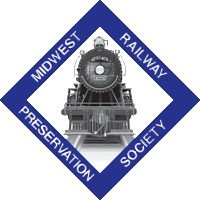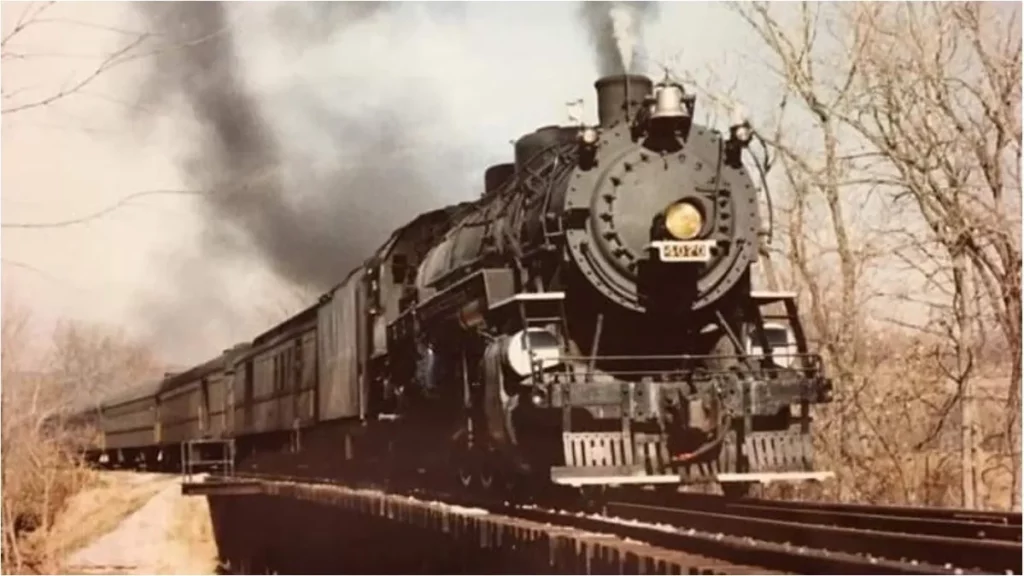Recently there have been a lot of negative comments posted on social media regarding MRPS and the ongoing restoration of our light Mikado steam locomotive 4070. Most of these posts come from people that believe the “fake news” of other social platforms and are unaware of the true history. With this article, based on historical research along with interviews of those involved we hope to set the record straight.
4070 was built by the American Locomotive Company (ALCO) in Schenectady, New York in 1918 and went into service for the Grand Trunk Western Railroad in western Michigan. It was originally numbered 474. In the 1930’s the locomotive was renumbered 3734 and outside of its’ normal service was assigned to be the backup power for President Harry Truman’s 1948 re-election campaign train in Michigan. In 1957, the locomotive was renumbered 4070 and its’ original tender was replaced with a larger one for longer distance travel. On March 29, 1960, 4070 made its’ last revenue run for the GTW.
It was stored in Durand, Michigan and sold for a proposed museum, but never moved. In 1966 it was leased to Midwest Railway Historical Foundation (the predecessor of Midwest Railway Preservation Society) for five years and moved to Chicago where it was restored to service and ran trips to Valparaiso, Indiana. Later, 4070 was stored under The Terminal Tower in Cleveland where Rapid Transit riders reported seeing it as “the Ghost Train”. Midwest purchased the locomotive in 1971 and used it to run short trips to Conneaut Lake Park in Pennsylvania and other short excursions. From 1975 to 1985 it was used to run trips through the Cuyahoga Valley on the old B&O right of way. Early trips left from a location near the Cleveland Zoo and ended at Hale Farm.
In 1983, 4070 took a hiatus from the Valley and went on location to Wayland, New York to appear in the movie “The Natural” where it shared top billing with Robert Redford. Another excursion of note that many people still talk about was the trip through Pittsburgh with 2102 to the Horseshoe Curve. One of the side rods was bent during the trip and the steam gods shone down leading the crew to a shop that was open in the middle of the night that was able to perform the necessary repairs. No trips were run from 1986-1987 because CSX had decided to abandon the Valley route. The last runs in the Valley were made from 1988 to 1990 when the locomotive was sidelined with cracks in the piston rings. At that time the restoration began with the removal of the boiler jacket and the insulation. The cylinder liners were cut out and the rods and main drivers (#3) were removed for running gear and bearing inspection.
During its’ last few years of operation, maintenance on the venerable old locomotive was somewhat lacking not because of laziness or disinterest, but due to a lack of money. Midwest at the time was locked into a terrible agreement that returned only twenty-five cents for every ticket sold back to the organization. Unfortunately, with so little income, money had to be channeled into overhead costs including rent, utilities and insurance.
Disassembly of 4070 continued in the roundhouse at a slow pace during the ’90’s and during that time Midwest was also tied up in litigation which could have impacted ownership of the locomotive. With ownership confirmed, MRPS was left with a large debt for legal fees that resulted in the organization having to sell off most of its’ passenger cars to raise money just to pay it off. One of the cars is the Pennsylvania Railroad business car that is connected to The Berea Depot restaurant. Many more were sold to private railroads on the east coast. Operating funds were scarce.
To make matters worse, in 2003 a portion of the roundhouse, stalls 11 through 15, that CSX had leased to a private business had collapsed taking a good portion of the wall between stalls 10 and 11 with it and a large portion of the roof as well. The City of Cleveland subsequently condemned the building. No work was allowed in the building until the conditions that forced the condemnation were rectified. Thus, while 4070 sat inside undercover, work on the locomotive could not move forward.
Midwest, lacking cash assets, was forced to take a personal loan from a member in order to make the required repairs to stalls 1 through 4 of the roundhouse. Repairs were begun in the Spring of 2011 and by the end of July, the work was completed and members were allowed back into the building. The organization then acquired a bank loan for $144,000.00 to shore up the wall of stall 10, fix the roof over stalls 1 through 4, add support bracing to the columns in stalls 6 through 10 as well as scaffolding to support the roof above stalls 6 through 10, a large portion of which had collapsed. Repayment of that bank loan was a huge burden that was just recently paid off.
The only good thing that came of the collapse was that it enabled MRPS to buy the property that included stalls 6 through 15 from CSX and today that belongs to us.
Disassembly of 4070 resumed, slowly at first because while the building was closed, some members lost interest and others, having grown older were unable to physically do the hard work involved in the process. Through the efforts of the project leader, newer members were recruited, many of them younger and eager to take on the hard, dirty work remaining.
Disassembly moved at a good pace. The steam tubes were all removed and the boiler was prepped for the ultrasound test. Test results of the boiler barrel showed that it was relatively trouble free with one small area in need of repair. That area has been fixed. There is a bigger job in store to repair the fire box but work is underway to remove it. A much larger job in store is replacement of the mud ring and a section of the crown sheet. Presently we have insufficient funds and qualified personnel to take on that task. It should be noted that there are local businesses that have come forward to donate materials and labor for parts of the restoration.
There have been a lot of comments regarding the fact that for the last few years the locomotive for the most part has been stored outside. Unfortunately, with only four working stalls in the roundhouse, Midwest has been forced to lease stalls in order to generate income. One long time tenant moved out last year but that stall is currently occupied by the business car “America” while it undergoes repairs and modernizations to get back on the road in private rail excursions. Stall two is leased to American Steam Railroad where they are busy restoring the Reading 2100 steam locomotive. Stalls three and four have been used to do maintenance on our other rail equipment and the occasional outside work to bring in money.
Although 4070 sits outside, work has continued to burn bolts for removal of the smoke box as well as removal of brake rigging. Currently, the cab sits in the machine shop where the rebuilding process is moving along with the help of Lincoln Electric who has plasma cut the side panels for us and has agreed to cut more plates as needed. The tender sits in stall four where it is about to be lifted so the truck assemblies can be removed and replaced with newer heavy duty assemblies with bearing boxes that we have on site. Plans are underway to begin tender restoration using sheet metal that likewise has been donated. Cad drawings are being generated to facilitate the rebuild.
Everything would be a lot easier if we could complete the restoration of stalls 6 through 10. That would provide enough space to give 4070 a permanent stall. Unfortunately, with a lack of funding, money is used on a priority basis with rent, utilities, insurance, etc., coming first followed by maintenance for ancillary equipment and the passenger cars that we lease out for revenue. We have been fortunate enough over the past year to be awarded grants that were earmarked for a specific purpose. We are applying for more this year.
Updates published in the Marker Lights have generated more interest and volunteers are showing up on a regular basis to work on the locomotive. All of the parts are on the premises and their locations being documented for future reference. Enhanced efforts are underway to raise money for the restoration fund and Wednesday work sessions have been reinstituted.
New members and volunteers are always welcome. People with a variety of skill sets are needed in all aspects of the project. Don’t just sit back and watch from a distance. It’s much more fun to come down and lend a hand. This is an opportunity to make new friends and also work with people of all backgrounds and even learn some new skills along the way. One day 4070 will run again. It is one of the primary goals of our organization. Wouldn’t it be great to know that you have been a part of its’ resurrection?

